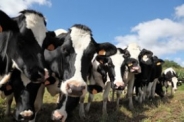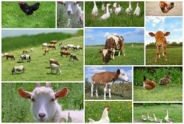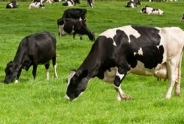Increasing Milking Frequency and Udder health
Jackson Wright, Dairy
Northwest New York Dairy, Livestock & Field Crops
April 2, 2012

Intuitively one would suspect that because frequent milking increases exposure to the mechanical forces applied during milking it also would increase the occurrence of "inverted" teat ends, or teat end hyperkeratosis, and risk for clinical mastitis. However, when considering the effects of frequent milking on udder health one should recognize that teat end hyperkeratosis is probably a natural response to milking as some degree of teat end hyperkeratosis occurs in a significant proportion of animals in all herds. Moreover, only very severe teat end hyperkeratosis is associated with an increased risk of clinical mastitis and mild to moderate teat end hyperkeratosis actually decreases the risk for SCC >199,000 cells/mL when compared with "normal" teat ends.
Maybe more importantly, previous reports investigating the effects of increasing milking frequency during early lactation have indicated that frequent milking has either no effect on SCC or even decreases SCC. In addition, when comparing a traditional 2X/d milking to cows on automated milking systems, animals on automated milking systems often visit the robot more frequently without exhibiting an increase in teat end hyperkeratosis.
Finally, when considering the effects of frequent milking on udder health, remember that when calves are allowed to nurse they feed an average of 7 times per day for over 45 min/d. Therefore, management strategies such as 3X or 4X milking during early lactation appear mild at best when compared to the natural feeding interval of the calf. What appears to be a more important factor than milking frequency on teat end health is proper maintenance of the milking equipment. This includes ensuring that vacuum pressure is correct and that the automatic take-offs are set on a moderate setting to prevent over-milking.
Upcoming Events
2026 Corn Congress
January 14, 2026
Henrietta, NY
Participant Registration for the 2026 Corn Congress NOW OPEN!
NOW OFFERING 1.5 DEC Recertification CREDITS
2026 Forage Congress
January 28, 2026
Nunda, NY
Register to attend 2026 Forage Congress!
2026 NWNY Dairy Day
February 5, 2026 : NWNY Dairy Day 2026
Perry, NY
Sponsorship and Registration OPEN!
The CCE NWNY Dairy, Livestock and Field Crops team will be holding it's 4th Annual "Dairy Day" on February 5, 2026! We will be bringing the latest in dairy research and hot topics to you with this in-person, 1-day conference.
Announcements
The NWNY Team is Hiring!
The NWNY Dairy, Livestock and Field Crops Team is currently looking for an Area Dairy Management Specialist as well as a Small Farms and Livestock Specialist:The full position descriptions and instructions on how to apply are available here:
Area Dairy Management Specialist: https://academicjobsonline.org/ajo/jobs/31178
Small Farms and Livestock Specialist: https://academicjobsonline.org/ajo/jobs/30979
Follow us on Instagram
See photos and reels of our most recent events and programs!Join us on Facebook!
Follow us on Facebook to get up to date posts about events, workshops and everything NWNY!Add us on LinkedIn!
Connect with us on LinkedIn to get more information about upcoming workshops and programs!





